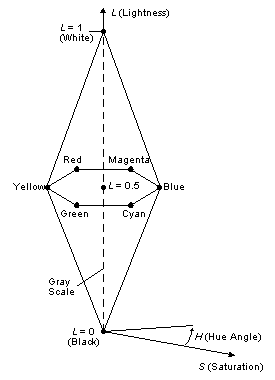
[This is preliminary documentation and subject to change.]
HLS color spaces are also widely used by artists. Its color components are hue, lightness, and saturation.
Hue has the same meaning as the HSV model, except that a hue angle of 0° corresponds to blue in this model. Magenta is at 60°, red is at 120°. As with the HSV model, complementary colors are 180° apart.
Lightness is the amount of black or white in a color. Increasing lightness adds white to the hue. Decreasing lightness adds black to the hue.
Saturation in the HLS model is a measure of the "purity" of a hue. As saturation is decreased, the hue becomes more gray. A saturation value of zero results in a grayscale value.
The following figure is a line drawing of HLS space, which is a double hexcone. Any horizontal cross section of the HLS color space is a hexagon. HLS is a normalized color space. That is, the lightness and saturation values range from 0.0 to 1.0 inclusive. Hue varies from 0° to 360° inclusive.

HLS color spaces can be device dependent or device independent.